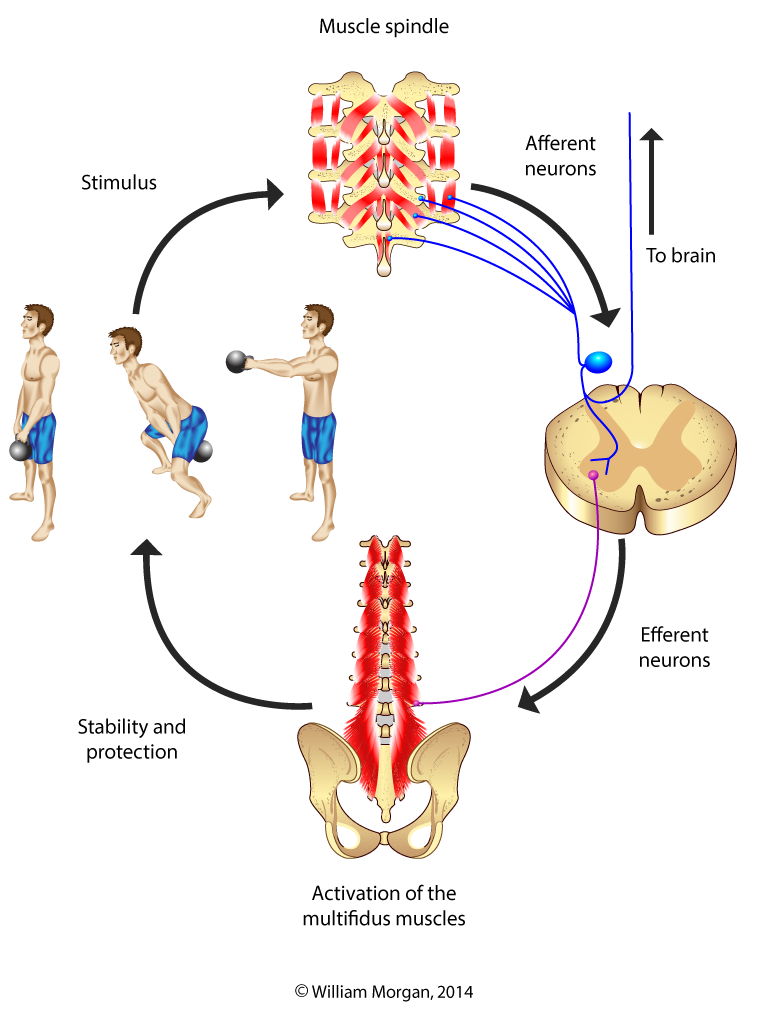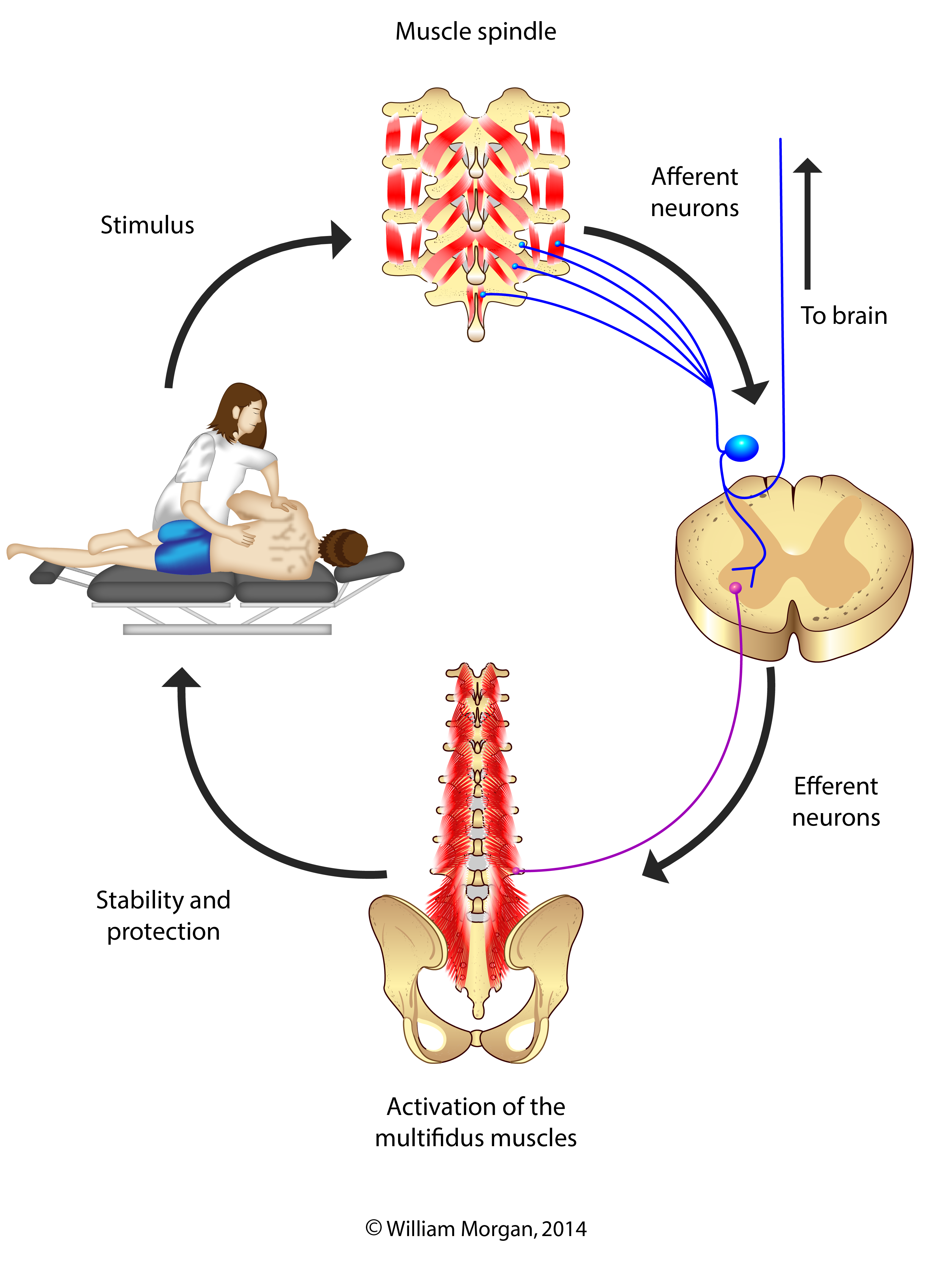Manipulation Activates Muscles of the Core
Motor control is an interactive process that allows the body to initiate activity to react to perturbations and other outside forces in a coordinated manner.
Normal global reactive motor control is complicated when you consider the vast amount of interactive and competing neuronal transmissions that are involved. However, in the simple example of evoking a patellar reflex, we can see that a stimulus, in this case a reflex hammer, places a rapid stretch on the muscle spindle fibers of the quadriceps. This sudden rapid stretch results in an afferent nerve transmission to the spinal cord and brain. There is a resulting efferent message that, traveling through an intermediate interneuron, inhibits contractions of the hamstring muscle, while another efferent transmission evokes a rapid contraction of the quadriceps.
This simple reflex arch is replicated in more complex patterns throughout the body.

Figure 1. The myotatic (stretch) reflex of the patellar tendon.
Applying this reflexive motor control model to the deep muscles of the core, it appears that there is a reflexive response between the small muscles of the spine (Intertransversarii, rotatores, and interspinales),1,2 ,3 and the spinal ligaments(3, 4) with the multifidus muscles. This reflexive control provides for a sensitive and reactive protective contractile response by the multifidus muscles.
Certainly there has been a proliferation of research on the effects of the multifidus muscles and other core stabilizers (like the transverse abdominis) on spinal health since the publication of several landmark studies by a group of physiotherapists (Richardson, Hodges, Jull, and Hides) from Australia in the late 1990s/early 2000s. These innovators have changed the way we look at reactive spinal stabilization. Yet in spite of this wave of interest, we are forced to proceed with incomplete and imperfect knowledge in this developing field of discovery.
Not all of the information from this wave of research is generalizable. For example, first time lower back pain patients recruited at an emergency room will respond differently than patients with chronic refractory lower back pain.6 Some of the information has been refuted and contested.7,8 Also, while the multifidus is important, it is not all important. There is no one muscle that dominates core motor control.9
What is evident is that the multifidus is a key component in the deep stabilization of the spine and is particularly susceptible to inhibition and atrophy following back injury. It is also evident from the research that the multifidus does not naturally recover from this post-injury inhibition and subsequent atrophy. Researchers are striving to find the right combinations of exercises to reverse this downward spiral.

Figure 2. The normal protective response of the multifidus muscles: When potentially deleterious motions occur, the muscle spindle fibers in the small muscles of the spine are stimulated and send afferent impulses to the cord. Reflexive efferent impulses from the cord then cause the multifidus muscles to contract. This creates stability and protection for that motion.
Manipulation Activation of Core Stabilization
A few recent studies have documented that the protective mechanisms of some of core muscles, particularly the multifidus and the transverse abdominis,10,11, 12,13,14 are enhanced by high-velocity low-amplitude manipulations. While gaps remain in the science, it appears that the adjustment (HVLA manipulation) activates the multifidus by way of stimulating the muscle spindle fibers of the small muscles of the spine. Pickar has demonstrated that manipulation stimulates the proprioceptive mechanism by exciting both muscle spindle fibers and golgi tendon organs. 15,16 Another study showed the effect the speed of the manipulation has on the muscle spindle response, the faster the manipulative impulse the greater the muscle spindle response. 17
Fritz found that the multifidus muscles retained increased recruitment one week following treatment. This indicates that the response was not simply a myotatic (stretch) reflex, but could be something more analogous to hitting the reset button on a computer.13
Chiropractic manipulation can enhance core stabilization, and particular exercises will also improve core stabilization. However, the synergistic effect of combining manipulation and exercise is preferred to either intervention alone. Core stabilization is a complex multifactorial system of sensory–motor control. It involves passive, active, and reactive components. As our understanding of the science of these mechanisms evolves, we will need to continually adapt our treatment programs and referral patterns to maximize our patients’ outcomes.

Figure 3. Improved activation of the lumbar multifidus muscles has been observed following spinal manipulation.
References
1 Bodduk MD,PhD. Clinical Anatomy of the Lumbar Spine and Sacrum. NY Churchill Livingstone 1997. 104-5.
2 Stuart McGill, Low Back Disorders: Second Edition © 2007 Stuart M. McGill
3 Carolyn Richardson, Paul Hodges, Julie Hides. Therapeutic Exercise for Lumbo Pelvic Stabilization – A Motor Control Approach for the Treatment and Prevention of Low Back Pain: 2nd Edition (c) Elsevier Limited, 2004
4 Solomonow M. Sensory-motor control of ligaments and associated neuromuscular disorders. J Electromyogr Kinesiol, 2006;16:549-67.
5 Le B, Davidson B, Solomonow D, et al. Neuromuscular control of lumbar instability following static work of various loads. Muscle Nerve, 2009;39:71-82.
6 Hides JL, Richardson CA, Jull GA. Multifidus recovery is not automatic after resolution of acute, first-episode low back pain. Spine, 2006; 21(23): 2763-9.
7 Standaert CM, Herring SM. Expert opinion and controversies in musculoskeletal and sports medicine: core stabilization as a treatment for low back pain. Arch Phys Med Rehabil, 2007;88:1734-6.
8Vera-Garcia FJ, Elvira JL, Brown SH, McGill SM. Effects of abdominal stabilization maneuvers on the control of spine motion and stability against sudden trunk perturbations. J Electromyogr Kinesiol, 2007;17:556-67.
9 Kavcic N, Grenier S, McGill SM. Determining the stabilizing role of individual torso muscles during rehabilitation exercises. Spine, 2004; 29(11): 1254-65
10 Gill NW, Teyan DS, Lee IE. Improved contraction of the transversus abdominis immediately following spinal manipulation: a case study using real-time ultrasound imaging. Manual Therapy, 2007; 12: 280-5.
11 Brenner A, et al. Improved activation of lumbar multifidus following spinal manipulation: a case report applying rehabilitative ultrasound imaging. JOSPT, 2007; 7:613-7.
12 Koppenhaver SL, et al. Association between changes in abdominal and lumbar muscle thickness and clinical improvement after spinal manipulation. JOSPT, 2011; 41 (6): 389-99.
13 Fritz JM, et al. Preliminary investigation of the mechanisms underlying the effects of manipulation; exploration of a multivariate model including spinal stiffness, multifidus recruitment, and clinical findings. Spine, 2011;36 (21): 1772-81.
14 Marshall PP, Murphy BD. The effect of sacroiliac joint manipulation on feed-forward activation times of the deep abdominal musculature. JMPT, 2006; 29: 196-202.
15 Pickar JG, Wheeler JD. Response of muscle proprioceptors to spinal manipulative-like loads in the anesthetized cat. JMPT, 2001;24 (1): 2-11.
16 Pickar JG, Kang YM. Paraspinal muscle spindle responses to the duration of a spinal manipulation under force control. JMPT, 2006; 29: 22-31.
17 Sung PS, Kang YM, Pickar JG. Effect of spinal manipulation duration of a spinal manipulation on low threshold mechanoreceptors in the lumbar paraspinal muscles: a preliminary report. Spine, 2005; 30 (1): 115-22.
